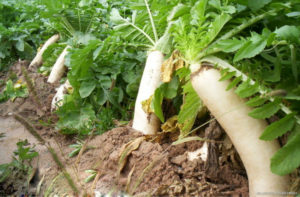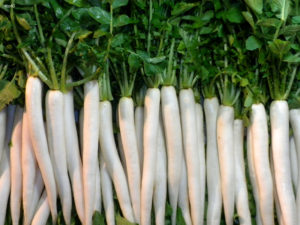General information:-
Brown color fruits are best for seed production. For seed extraction, fruit pulp is taken out in fresh water for 1-2 days for the easy separation of seeds. The seeds are then rubbed with hands and as a result heavy seeds will settle down in water and then they are preserved for further use.
Climate:-
Temperature
18-25°C
Season
Rainfall
100-225cm
Season
Sowing Temperature
20-25°C
Season
Harvesting Temperature
18-20°C
 Soil:-
Soil:-
It can be grown on all type of soils but give best result when grown on light friable, sandy loam soil. Avoid heavy or compact soils as it produce rough, malformed roots. Ideal pH of soil for good growth is 5.5 to 6.8
Popular varieties with yield:-
Japanese white: Optimum time for sowing is from November-December. It is introduced in India from Japan. In northern plains it is recommended for late sowing and in hilly areas recommended for cultivation in July-September. Roots are cylindrical and having pure white color. Gives average yield of 160qtl/acre.
Pusa chetki: Optimum time for sowing is from April-August. Early maturing variety suitable for seed production for Punjab region. Its roots are smooth, snow white color and medium long. It gives average yield of 105qtl/acre and seed yield of 4.5qtl/acre.
Pusa Himani: Suitable for sowing in fortnight of January-February. Its root are white with green shoulders. Ready to harvest in 60-65days after sowing. Gives average yield of 160qtl/acre.
Punjab Pasand: Optimum time for sowing is from second fortnight of March. It is early maturing variety, ready to harvest in 45days after sowing. Roots are long, white and free from hair. Suitable for sowing in main season as well as for off season. In main season, gives average yield of 215qtl/acre where as in off season gives average yield of 140qtl/acre.
Punjab Safed Mooli-2: The variety matures in 60days and gives an average yield of 236qtl/acre.
Other state varieties:
Pusa Deshi: Suitable for sowing in northern plains. Roots are of pure white color. Ready to harvest in 50-55days after sowing.
Pusa Reshmi: Variety is suitable for early sowing. Ready to harvest in 50 to 60days.
Arka Nishant: Long and pink root variety. Ready to harvest in 50-55days.
Rapid Red White Tipped: Very early maturing European table type variety. Ready to harvest in 25-30days. Roots are small and bright red colored with pure white flesh color.
Land preparation:-
Plough land thoroughly and make land weed and clods free. Add well decomposed cow dung of 5-10ton/acre and mix well in soils at time of land preparation. Avoid use of undecomposed or free cowdung as it will leads to forking of fleshy roots.
Sowing:-
Time of sowing
Pusa Himani: Optimum time for sowing is January-February.
Punjab Pasand: Optimum time for sowing is from second fortnight of March where as for Pusa chetki optimum time for sowing is from April-August.
Japanese white: Optimum time for sowing is from November-December.
Spacing
Use row to row spacing of 45cm and plant to plant spacing of 7.5cm.
Sowing Depth
For good growth, sow seeds at depth of 1.5cm
Method of Sowing
Sowing can be done by Line Sowing and Broadcasting method.
Seed Rate
For sowing of one acre land seed rate of 4-5kg is sufficient. It is sown on ridge for proper root development.
Seed Rate
For sowing of one acre land seed rate of 4-5kg is sufficient. It is sown on ridge for proper root development.
Seed Rate
For sowing of one acre land seed rate of 4-5kg is sufficient. It is sown on ridge for proper root development.
Seed Rate
For sowing of one acre land seed rate of 4-5kg is sufficient. It is sown on ridge for proper root development.
Seed:
Seed Rate
For sowing of one acre land seed rate of 4-5kg is sufficient. It is sown on ridge for proper root development.
Fertilizer:-
Fertilizer Requirement (kg/acre)
UREA SSP MURIATE OF POTASH
65 50 #
Nutrients Requirement (kg/acre)
NITROGEN PHOSPHORUS POTASH
30 8 #
Along with well decomposed cowdung, apply Nitrogen@25kg (in form of Urea@55kg), Phosphorus@12kg (in form of SSP@ 75kg/acre) per acre in soil at time of sowing.
Weed control:-
Take interculture operation like weeding and hoeing to keep check on weed growth also to provide soil aeration. Take one weeding operation, two to three weeks after sowing. After weeding, carryout earthing operation.
Irrigation:-
After sowing, apply first irrigation, it will help in good germination. Depending upon soil type and climate, apply remaining irrigations at interval of 6-7days in summer and 10-12 days interval in winter month. Overall radish required five to six irrigations. Avoid excessive irrigation as it will leads misshape of roots and numerous hair growth. In summer season, provide pre-harvest light irrigation. It will keep root fresh and reduce pungency.
Plant protection:-
Aphid: Serious pest of Radish, attacked at seedling as well as at maturity stage. If infestation is observed, spraying of Malathion 50EC@1ml/Litre of water should be done. Repeat spray for two-three times at interval of 10days.
Disease and their control:-
Alternaria blight: Slightly raised, yellow spots are observed on leaves. Infection is rapidly spread in rainy season. Fungus spread on pods and seeds loose viability.
If infestation is observed, spraying of Mancozeb@2gm/lit of water or Carbendazim@1gm/lit of water should be done to control this disease.Flea beetles and mustard saw fly: If infestation is observed in field, to control take spray of Malathion 50EC@1ml/Litre of water. Repeat spray for two-three times at interval of 10days.
Flea beetles and mustard saw fly: If infestation is observed in field, to control take spray of Malathion 50EC@1ml/Litre of water. Repeat spray for two-three times at interval of 10days.
Harvesting:-
Depending upon variety, radish is ready for harvesting in 25-60days after sowing. Harvesting is done manually by uprooting plants. Harvested roots are washed and then graded upon size.
Post harvest:-
After harvesting grading of radish depending upon size is carried out. The product is marketed loose to sometime they are packed in gunny bags or basket.
